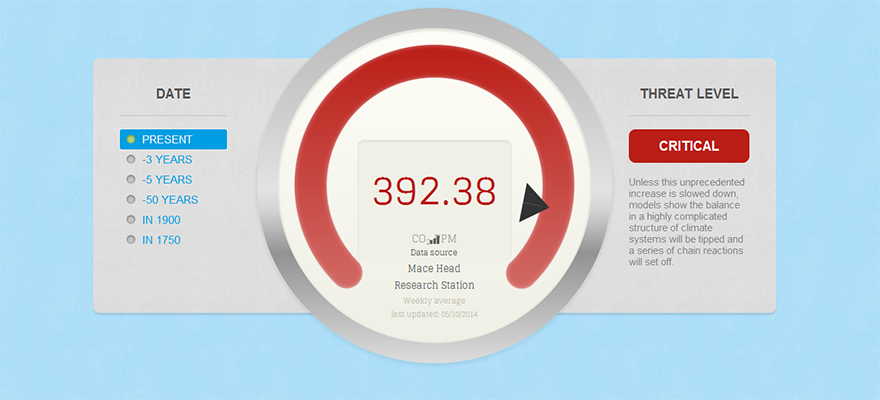Climate-KIC’s new online CO2 meter indicates global carbon levels

As efforts to reduce greenhouse gas emissions around the world accelerate, Climate-KIC launches a new online CO2 meter to highlight current CO2 levels in the atmosphere, how levels are still rising, and to emphasise the urgency needed to reduce harmful emissions.
With atmospheric CO2 consistently hitting levels of over 400 PPM (parts per million) this spring according to figures released by the US National Oceanic and Atmospheric Administration, Climate-KIC’s new meter also acts as a timely global threat level indicator – showing how close global CO2 levels get to 450 PPM, a maximum level suggested by climate scientists beyond which the effects of climate change would be irreversible.
The online meter combines a live data feed drawing on European data, updated regularly to show the precise level of CO2 in the earth’s atmosphere today, and comparison tools to show how CO2 levels have changed over time. For anyone wanting to see for themselves exactly how much CO2 is currently in the atmosphere, Climate-KIC’s online meter is a definitive and easy to understand tool.
World Summit of Regions for Climate
The launch of the meter comes in the run-up to the World Summit of Regions for Climate, taking place in Paris on 10 and 11 October. Climate-KIC’s new CEO, Bertrand van Ee, will be speaking at the summit and will highlight the strategic importance of developing more sustainable cities to reducing greenhouse gas emissions.
Chaired by former Governor of California and Founding Chair of R20 Regions of Climate Action, Arnold Schwarzenegger, this summit of global importance will gather regional and local governments from the five continents, as well as economic leaders, to contribute to a new international agreement on climate change.
Technological innovation
Richard Templer, director of Climate-KIC’s centre in the UK, commented: “CO2 levels are rising, it’s a fact – indeed the Global Carbon Project announced last month that Global emissions of greenhouse gases jumped 2.3% in 2013 to record levels.
“However, Climate-KIC and our broad network of partners are working hard to support and encourage the entrepreneurs, scientists and students inventing new technologies that will decrease the amount of CO2 that humans put into the atmosphere and thus avert disaster,” said Templer.
Thanh-Tâm Lê, director of Climate-KIC’s centre in France, said: “Thanks to our collaboration with Laboratoire des Sciences du Climat et de l’Environnement and other partners, our new CO2 meter will show the size of the challenge we face.”
“What it takes to rise to it is our ability to drive technological innovation,” emphasised Lê , “And to work together across industries and countries to remove our reliance on old polluting technologies – and to empower big and small CO2 emitters to use our innovations, and ultimately reduce emissions down to tolerable levels. This is our mission at Climate-KIC and, in this way, we can shape the world’s next economy founded on the principles of sustainability.”
Mace Head measurement station
The meter draws on data from a joint Irish-French-British measurement station. Climate-KIC’s online CO2 meter uses measurements updated regularly from the Mace Head research station on the west coast of Ireland, Europe’s best environment for atmospheric measurements.
Jane Burston, head of the Centre for Carbon Measurement at Climate-KIC partner the UK’s National Physical Laboratory, commented: “We need to know the real size of the challenge and to be able to measure the success or otherwise of our efforts in reducing emissions and mitigating climate change.”
“This new online CO2 meter is the latest step in making that information available to as many people as possible,” said Burston.
By making that data available online in an easy to understand format Climate-KIC is making the scientific measurement of how much carbon is currently in the air as easily accessible as possible to a wider non-scientific audience – helping to explain the importance of reducing greenhouse gas emissions.
The organisations involved in running the Mace Head station and the CO2 equipment are Laboratoire des Sciences du Climat et de l’Environnement (LSCE), through support from CNRS, CEA and OVSQ in France, NUI Galway’s Centre for Climate and Air Pollution Studies (C-CAPS), the Irish Environmental Protection Agency, and the University of Bristol through the Department of Energy & Climate Change in the UK.

 Share this page
Share this page


